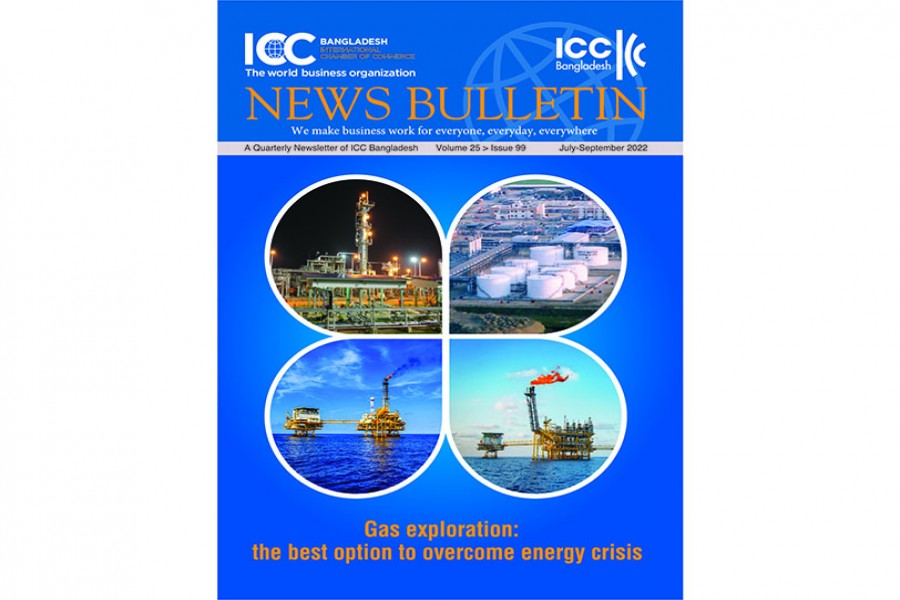The global energy landscape has been impacted by increased market uncertainty due to the Russia-Ukraine war. Even before the war began, there was a rebound in energy demand triggered by supply constraints and price spikes for multiple commodities. While gas price hit a 30-year low at the start of the pandemic in 2020, it reached a nearly two-decade high in 2021. Power prices show similar volatility, according to the editorial of the current News Bulletin (July-September 2022) of the International Chamber of Commerce-Bangladesh (ICCB) released today (Wednesday).
The transition to a low-carbon economy is continuing to gain momentum in the long-term shift to low-carbon energy systems and has been accelerating in several respects. In the context of COP26, developed countries as well as many large corporate houses have committed to achieving net zero emissions within the next few decades to fight the climate change catastrophe, according to a statement.
The Russia-Ukraine war is certainly a reason for the global energy crisis which also affected Bangladesh. But experts said with all certainty that even if the war had not taken place, Bangladesh would have still faced an energy crisis. The production and supply from local gas fields have been declining since 2015 and will continue to decline in the near future. On the other hand, geoscientific studies testify that there is more untapped natural gas in Bangladesh than what has so far been extracted.
A two-year joint study (2001) by the US Geological Survey (USGS) and Petrobangla shows that Bangladesh has a mean probability (50 per cent) of undiscovered natural gas resources to the tune of about 32 trillion cubic feet (Tcf). The Norwegian Petroleum Directorate (NDP) and Hydrocarbon Unit (HCU) in another joint study (2001) suggested that the mean probability of Bangladesh’s undiscovered gas resources is 42 Tcf. In 2011 Ramboll, a European oil and gas consultant updated the undiscovered gas resource assessments for Bangladesh and suggested that it is 34 Tcf in 90 per cent probability.
According to experts, Bangladesh consumes about one trillion cubic feet of gas per year. It means that by exploring the untapped gas resource of 32-34 Tcf, the country can be ensured of gas supply for the next 30 years. Although Bangladesh has further potential in the gas sector, the number of exploration gas wells is less than many other gas basins in the world.
Bangladesh has an area of 147,000 sq. km and has so far drilled about 100 exploratory wells in total. Indian State of Tripura, on the other hand, has an area of 10,000 sq. km and has drilled more than 150 exploratory wells. Such statistic shows how poor the rate of exploration in Bangladesh actually is. Yet, Bangladesh discovered more gas reserves than Tripura.
Out of 25,500MW of electricity generation capacity, 3,500 MW is off-grid (solar home and captive), while 4,000 MW cannot be operational because of forced/ unforced shutdown and fuel shortage. To meet up the present crisis and to meet future need for electricity generation, Bangladesh has started importing liquefied natural gas (LNG).
In 2026, Bangladesh will become a middle income country and as such is going to lose a number of benefits of LDCs. Besides, with the declining foreign exchange reserve, the country is expected to be hard-pressed in the next 2/3 years’ time when the debt re-payment becomes due. In addition, US$26 billion debt re-payment of the private sector borrowing may also make it difficult to manage foreign debt re-payment.
Therefore, dependence on LNG imports may work out in the short-term, but in the long-run, the price volatility and current global economic uncertainty would make import unsustainable and put pressure on much-needed foreign exchange reserves.
Bangladesh Government is targeting to achieve export earnings of US$100 billion by 2026. But with the on-going energy crisis it might be difficult to achieve the target as production in most of the industries are well below their capacity due to frequent shut down.
It has been 10 years since the Government has successfully own the maritime boundary dispute in the Bay of Bengal. According to experts, the deltaic build of mainland Bangladesh and its offshore, for all geo-scientific reasons, have been rated as highly prospective areas for natural gas. Proof of such rating is evidenced in the adjacent areas bordering Bangladesh, notably the offshore Rakhaine basin in Myanmar where large-scale gas fields have been discovered since the maritime dispute with Bangladesh was settled in 2012.
Bangladesh should move faster with its exploration activities both on-shore and off-shore to replace expensive LNG with its own natural gas reserve as long as such a resource base is scientifically reckoned.


